University Bank: Analysis of CSR Campaign for Brand Improvement
VerifiedAdded on 2022/11/17
|15
|3408
|310
Report
AI Summary
This report analyzes a bank's CSR campaign, initiated to improve its image after a series of scandals. The bank's strategy involves donating to non-profit organizations fighting violence against women and advertising through social media. However, the report identifies potential negative public reactions due to factors like lack of diversity within the bank, the potential for the campaign to be perceived as insincere, and the use of social media which may alienate older customers. The methodology includes secondary analysis, employing Neohumanist and Radical Structuralist theories to understand the issues. The literature review discusses critical perspectives on CSR, reasons for public backlash, and proposes solutions like acknowledging problems, considering public perspectives, and taking quick action. The report emphasizes the importance of addressing social isolation, both individual and organizational, and the need for a well-defined, public-oriented campaign to rebuild trust and improve brand image. Recommendations include acknowledging the problem, considering public perspectives, and taking quick action to mitigate negative public reaction. The report highlights the importance of addressing diversity issues within the bank and ensuring the CSR campaign aligns with public needs and values.
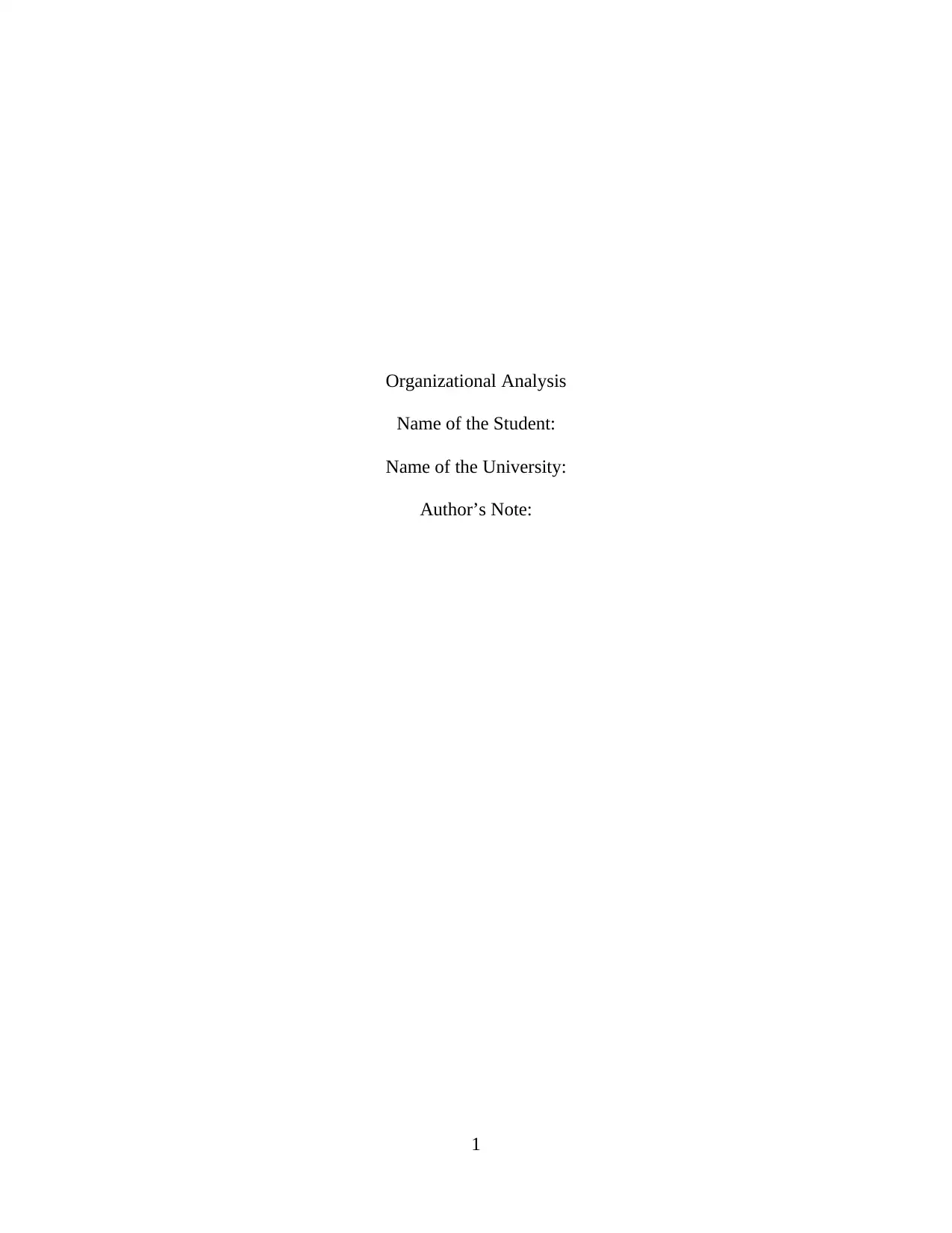
Organizational Analysis
Name of the Student:
Name of the University:
Author’s Note:
1
Name of the Student:
Name of the University:
Author’s Note:
1
Paraphrase This Document
Need a fresh take? Get an instant paraphrase of this document with our AI Paraphraser
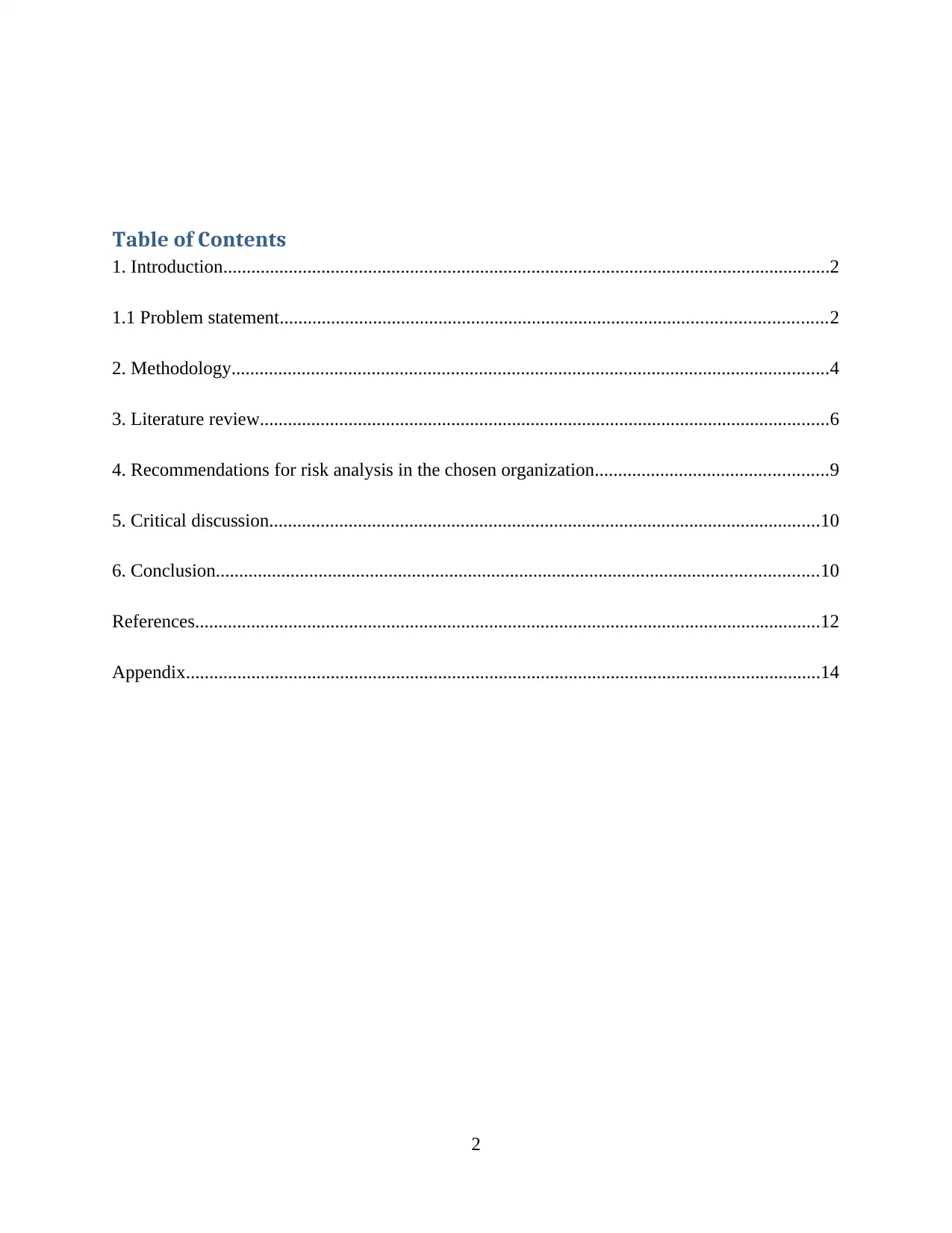
Table of Contents
1. Introduction..................................................................................................................................2
1.1 Problem statement.....................................................................................................................2
2. Methodology................................................................................................................................4
3. Literature review..........................................................................................................................6
4. Recommendations for risk analysis in the chosen organization..................................................9
5. Critical discussion......................................................................................................................10
6. Conclusion.................................................................................................................................10
References......................................................................................................................................12
Appendix........................................................................................................................................14
2
1. Introduction..................................................................................................................................2
1.1 Problem statement.....................................................................................................................2
2. Methodology................................................................................................................................4
3. Literature review..........................................................................................................................6
4. Recommendations for risk analysis in the chosen organization..................................................9
5. Critical discussion......................................................................................................................10
6. Conclusion.................................................................................................................................10
References......................................................................................................................................12
Appendix........................................................................................................................................14
2
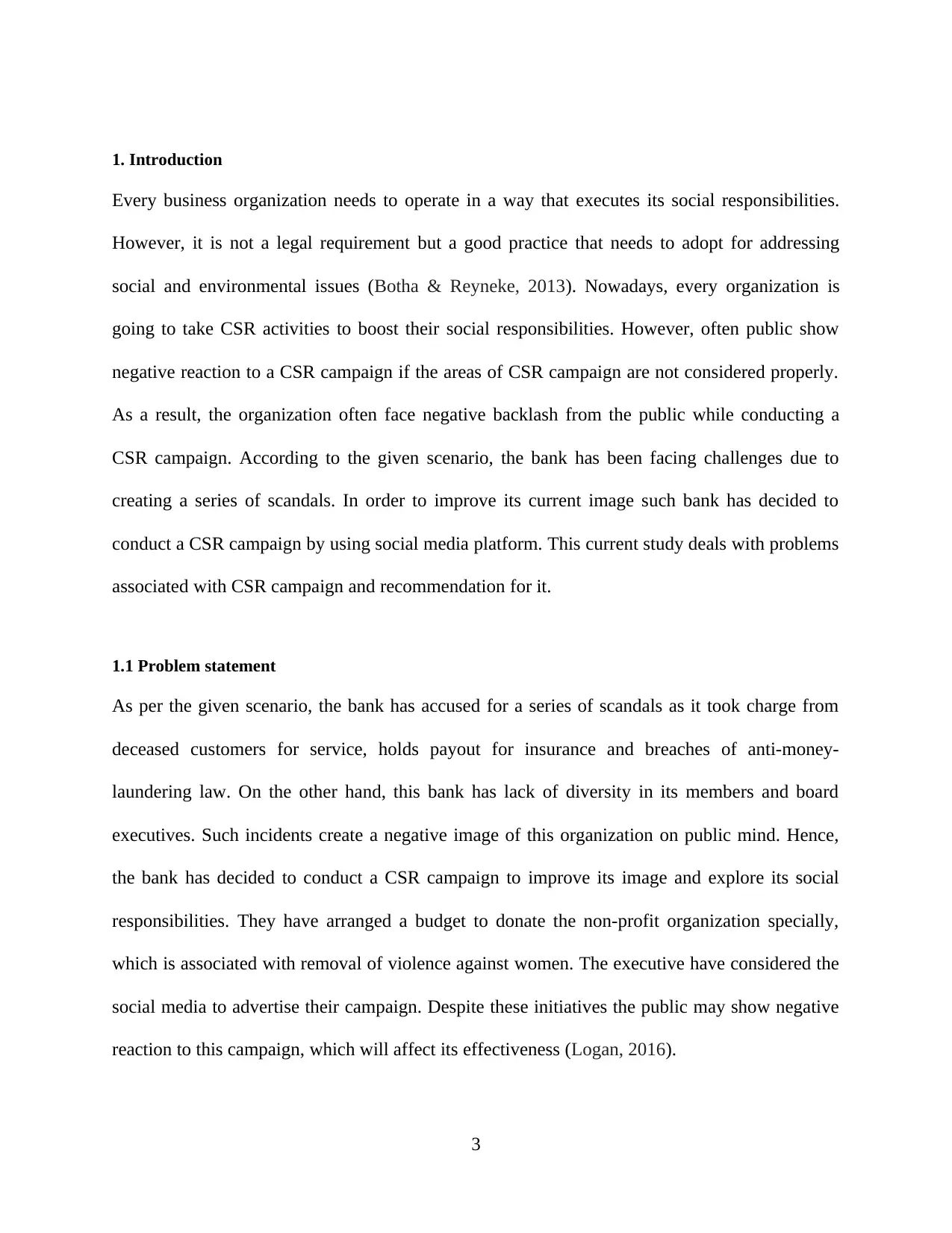
1. Introduction
Every business organization needs to operate in a way that executes its social responsibilities.
However, it is not a legal requirement but a good practice that needs to adopt for addressing
social and environmental issues (Botha & Reyneke, 2013). Nowadays, every organization is
going to take CSR activities to boost their social responsibilities. However, often public show
negative reaction to a CSR campaign if the areas of CSR campaign are not considered properly.
As a result, the organization often face negative backlash from the public while conducting a
CSR campaign. According to the given scenario, the bank has been facing challenges due to
creating a series of scandals. In order to improve its current image such bank has decided to
conduct a CSR campaign by using social media platform. This current study deals with problems
associated with CSR campaign and recommendation for it.
1.1 Problem statement
As per the given scenario, the bank has accused for a series of scandals as it took charge from
deceased customers for service, holds payout for insurance and breaches of anti-money-
laundering law. On the other hand, this bank has lack of diversity in its members and board
executives. Such incidents create a negative image of this organization on public mind. Hence,
the bank has decided to conduct a CSR campaign to improve its image and explore its social
responsibilities. They have arranged a budget to donate the non-profit organization specially,
which is associated with removal of violence against women. The executive have considered the
social media to advertise their campaign. Despite these initiatives the public may show negative
reaction to this campaign, which will affect its effectiveness (Logan, 2016).
3
Every business organization needs to operate in a way that executes its social responsibilities.
However, it is not a legal requirement but a good practice that needs to adopt for addressing
social and environmental issues (Botha & Reyneke, 2013). Nowadays, every organization is
going to take CSR activities to boost their social responsibilities. However, often public show
negative reaction to a CSR campaign if the areas of CSR campaign are not considered properly.
As a result, the organization often face negative backlash from the public while conducting a
CSR campaign. According to the given scenario, the bank has been facing challenges due to
creating a series of scandals. In order to improve its current image such bank has decided to
conduct a CSR campaign by using social media platform. This current study deals with problems
associated with CSR campaign and recommendation for it.
1.1 Problem statement
As per the given scenario, the bank has accused for a series of scandals as it took charge from
deceased customers for service, holds payout for insurance and breaches of anti-money-
laundering law. On the other hand, this bank has lack of diversity in its members and board
executives. Such incidents create a negative image of this organization on public mind. Hence,
the bank has decided to conduct a CSR campaign to improve its image and explore its social
responsibilities. They have arranged a budget to donate the non-profit organization specially,
which is associated with removal of violence against women. The executive have considered the
social media to advertise their campaign. Despite these initiatives the public may show negative
reaction to this campaign, which will affect its effectiveness (Logan, 2016).
3
⊘ This is a preview!⊘
Do you want full access?
Subscribe today to unlock all pages.

Trusted by 1+ million students worldwide
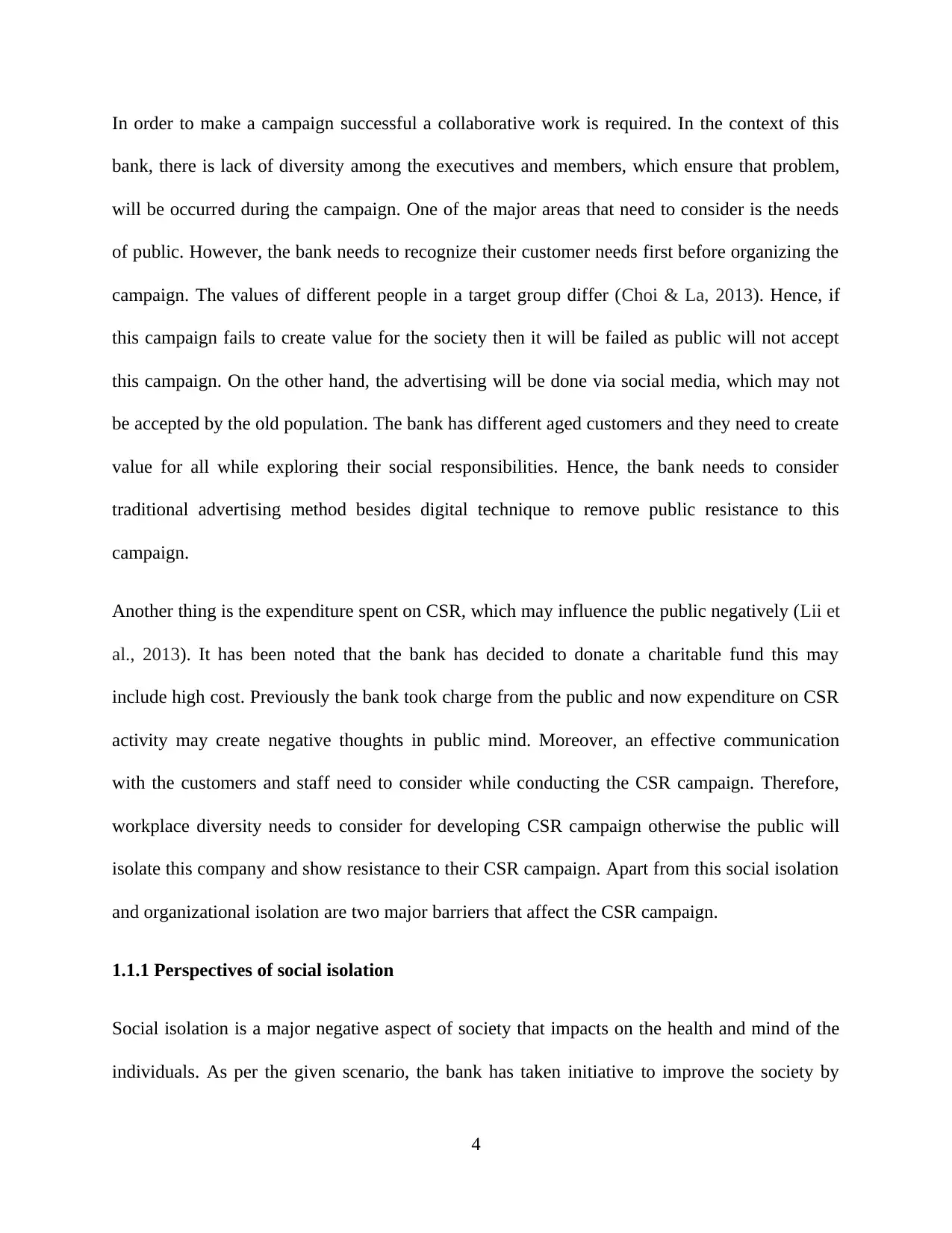
In order to make a campaign successful a collaborative work is required. In the context of this
bank, there is lack of diversity among the executives and members, which ensure that problem,
will be occurred during the campaign. One of the major areas that need to consider is the needs
of public. However, the bank needs to recognize their customer needs first before organizing the
campaign. The values of different people in a target group differ (Choi & La, 2013). Hence, if
this campaign fails to create value for the society then it will be failed as public will not accept
this campaign. On the other hand, the advertising will be done via social media, which may not
be accepted by the old population. The bank has different aged customers and they need to create
value for all while exploring their social responsibilities. Hence, the bank needs to consider
traditional advertising method besides digital technique to remove public resistance to this
campaign.
Another thing is the expenditure spent on CSR, which may influence the public negatively (Lii et
al., 2013). It has been noted that the bank has decided to donate a charitable fund this may
include high cost. Previously the bank took charge from the public and now expenditure on CSR
activity may create negative thoughts in public mind. Moreover, an effective communication
with the customers and staff need to consider while conducting the CSR campaign. Therefore,
workplace diversity needs to consider for developing CSR campaign otherwise the public will
isolate this company and show resistance to their CSR campaign. Apart from this social isolation
and organizational isolation are two major barriers that affect the CSR campaign.
1.1.1 Perspectives of social isolation
Social isolation is a major negative aspect of society that impacts on the health and mind of the
individuals. As per the given scenario, the bank has taken initiative to improve the society by
4
bank, there is lack of diversity among the executives and members, which ensure that problem,
will be occurred during the campaign. One of the major areas that need to consider is the needs
of public. However, the bank needs to recognize their customer needs first before organizing the
campaign. The values of different people in a target group differ (Choi & La, 2013). Hence, if
this campaign fails to create value for the society then it will be failed as public will not accept
this campaign. On the other hand, the advertising will be done via social media, which may not
be accepted by the old population. The bank has different aged customers and they need to create
value for all while exploring their social responsibilities. Hence, the bank needs to consider
traditional advertising method besides digital technique to remove public resistance to this
campaign.
Another thing is the expenditure spent on CSR, which may influence the public negatively (Lii et
al., 2013). It has been noted that the bank has decided to donate a charitable fund this may
include high cost. Previously the bank took charge from the public and now expenditure on CSR
activity may create negative thoughts in public mind. Moreover, an effective communication
with the customers and staff need to consider while conducting the CSR campaign. Therefore,
workplace diversity needs to consider for developing CSR campaign otherwise the public will
isolate this company and show resistance to their CSR campaign. Apart from this social isolation
and organizational isolation are two major barriers that affect the CSR campaign.
1.1.1 Perspectives of social isolation
Social isolation is a major negative aspect of society that impacts on the health and mind of the
individuals. As per the given scenario, the bank has taken initiative to improve the society by
4
Paraphrase This Document
Need a fresh take? Get an instant paraphrase of this document with our AI Paraphraser
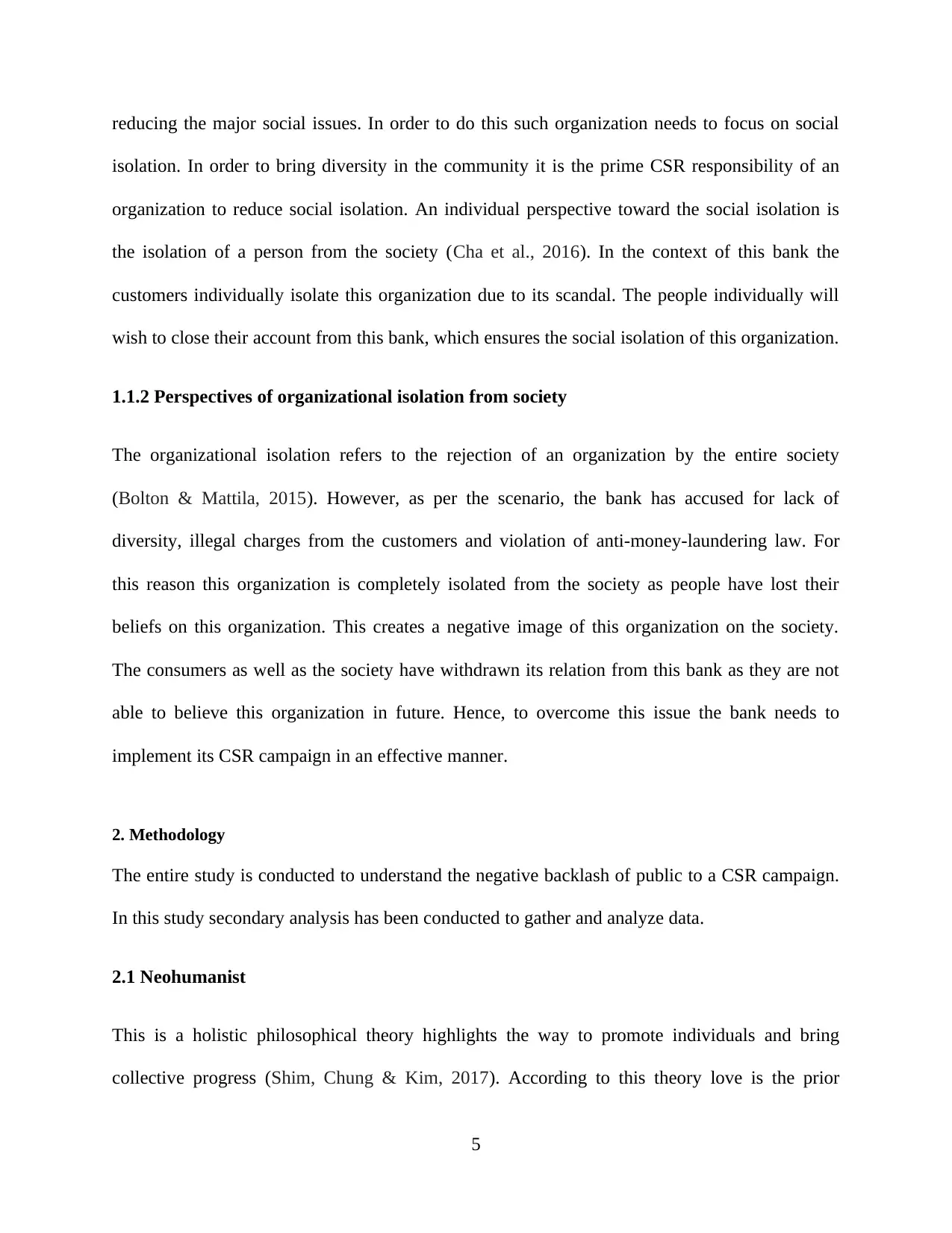
reducing the major social issues. In order to do this such organization needs to focus on social
isolation. In order to bring diversity in the community it is the prime CSR responsibility of an
organization to reduce social isolation. An individual perspective toward the social isolation is
the isolation of a person from the society (Cha et al., 2016). In the context of this bank the
customers individually isolate this organization due to its scandal. The people individually will
wish to close their account from this bank, which ensures the social isolation of this organization.
1.1.2 Perspectives of organizational isolation from society
The organizational isolation refers to the rejection of an organization by the entire society
(Bolton & Mattila, 2015). However, as per the scenario, the bank has accused for lack of
diversity, illegal charges from the customers and violation of anti-money-laundering law. For
this reason this organization is completely isolated from the society as people have lost their
beliefs on this organization. This creates a negative image of this organization on the society.
The consumers as well as the society have withdrawn its relation from this bank as they are not
able to believe this organization in future. Hence, to overcome this issue the bank needs to
implement its CSR campaign in an effective manner.
2. Methodology
The entire study is conducted to understand the negative backlash of public to a CSR campaign.
In this study secondary analysis has been conducted to gather and analyze data.
2.1 Neohumanist
This is a holistic philosophical theory highlights the way to promote individuals and bring
collective progress (Shim, Chung & Kim, 2017). According to this theory love is the prior
5
isolation. In order to bring diversity in the community it is the prime CSR responsibility of an
organization to reduce social isolation. An individual perspective toward the social isolation is
the isolation of a person from the society (Cha et al., 2016). In the context of this bank the
customers individually isolate this organization due to its scandal. The people individually will
wish to close their account from this bank, which ensures the social isolation of this organization.
1.1.2 Perspectives of organizational isolation from society
The organizational isolation refers to the rejection of an organization by the entire society
(Bolton & Mattila, 2015). However, as per the scenario, the bank has accused for lack of
diversity, illegal charges from the customers and violation of anti-money-laundering law. For
this reason this organization is completely isolated from the society as people have lost their
beliefs on this organization. This creates a negative image of this organization on the society.
The consumers as well as the society have withdrawn its relation from this bank as they are not
able to believe this organization in future. Hence, to overcome this issue the bank needs to
implement its CSR campaign in an effective manner.
2. Methodology
The entire study is conducted to understand the negative backlash of public to a CSR campaign.
In this study secondary analysis has been conducted to gather and analyze data.
2.1 Neohumanist
This is a holistic philosophical theory highlights the way to promote individuals and bring
collective progress (Shim, Chung & Kim, 2017). According to this theory love is the prior
5
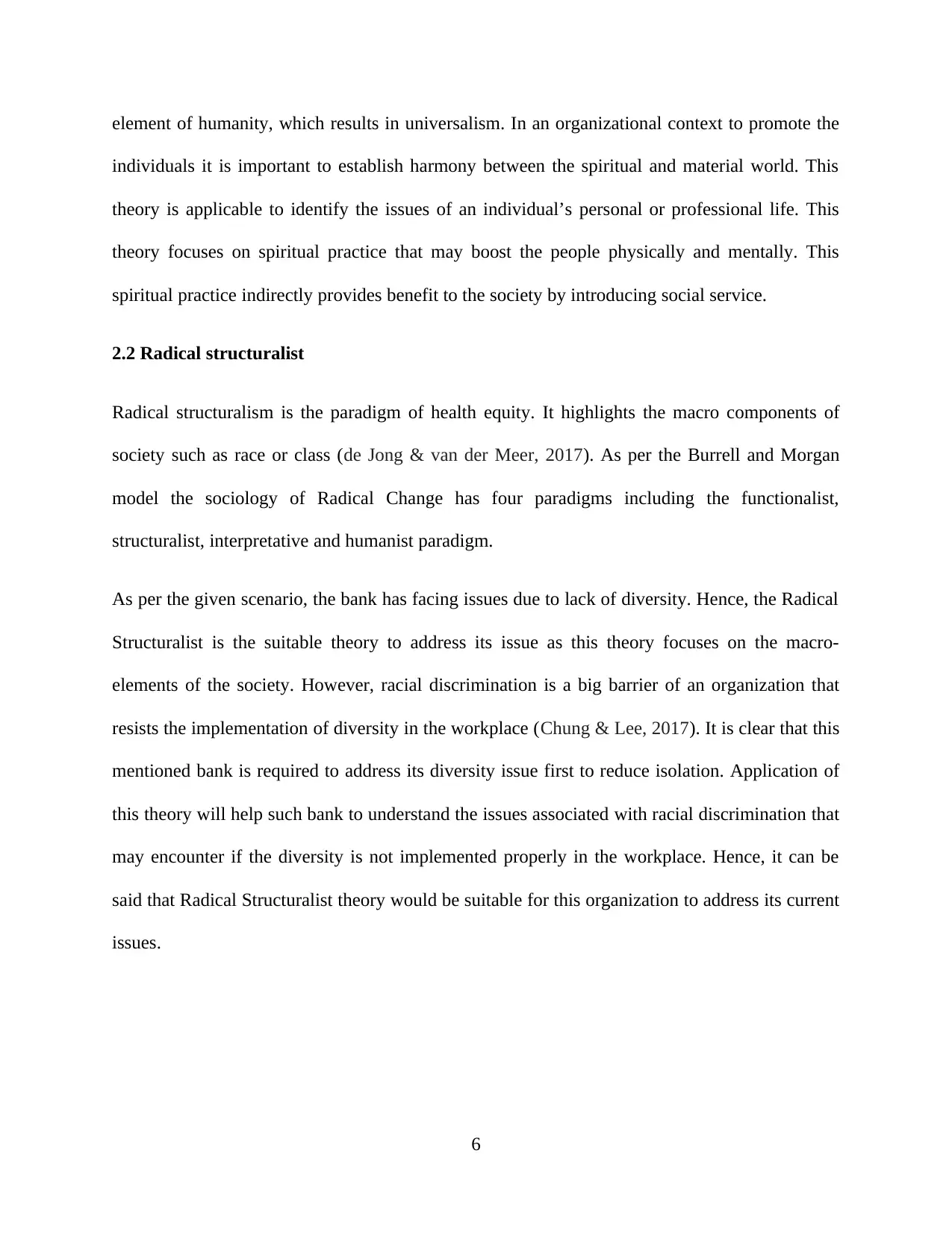
element of humanity, which results in universalism. In an organizational context to promote the
individuals it is important to establish harmony between the spiritual and material world. This
theory is applicable to identify the issues of an individual’s personal or professional life. This
theory focuses on spiritual practice that may boost the people physically and mentally. This
spiritual practice indirectly provides benefit to the society by introducing social service.
2.2 Radical structuralist
Radical structuralism is the paradigm of health equity. It highlights the macro components of
society such as race or class (de Jong & van der Meer, 2017). As per the Burrell and Morgan
model the sociology of Radical Change has four paradigms including the functionalist,
structuralist, interpretative and humanist paradigm.
As per the given scenario, the bank has facing issues due to lack of diversity. Hence, the Radical
Structuralist is the suitable theory to address its issue as this theory focuses on the macro-
elements of the society. However, racial discrimination is a big barrier of an organization that
resists the implementation of diversity in the workplace (Chung & Lee, 2017). It is clear that this
mentioned bank is required to address its diversity issue first to reduce isolation. Application of
this theory will help such bank to understand the issues associated with racial discrimination that
may encounter if the diversity is not implemented properly in the workplace. Hence, it can be
said that Radical Structuralist theory would be suitable for this organization to address its current
issues.
6
individuals it is important to establish harmony between the spiritual and material world. This
theory is applicable to identify the issues of an individual’s personal or professional life. This
theory focuses on spiritual practice that may boost the people physically and mentally. This
spiritual practice indirectly provides benefit to the society by introducing social service.
2.2 Radical structuralist
Radical structuralism is the paradigm of health equity. It highlights the macro components of
society such as race or class (de Jong & van der Meer, 2017). As per the Burrell and Morgan
model the sociology of Radical Change has four paradigms including the functionalist,
structuralist, interpretative and humanist paradigm.
As per the given scenario, the bank has facing issues due to lack of diversity. Hence, the Radical
Structuralist is the suitable theory to address its issue as this theory focuses on the macro-
elements of the society. However, racial discrimination is a big barrier of an organization that
resists the implementation of diversity in the workplace (Chung & Lee, 2017). It is clear that this
mentioned bank is required to address its diversity issue first to reduce isolation. Application of
this theory will help such bank to understand the issues associated with racial discrimination that
may encounter if the diversity is not implemented properly in the workplace. Hence, it can be
said that Radical Structuralist theory would be suitable for this organization to address its current
issues.
6
⊘ This is a preview!⊘
Do you want full access?
Subscribe today to unlock all pages.

Trusted by 1+ million students worldwide
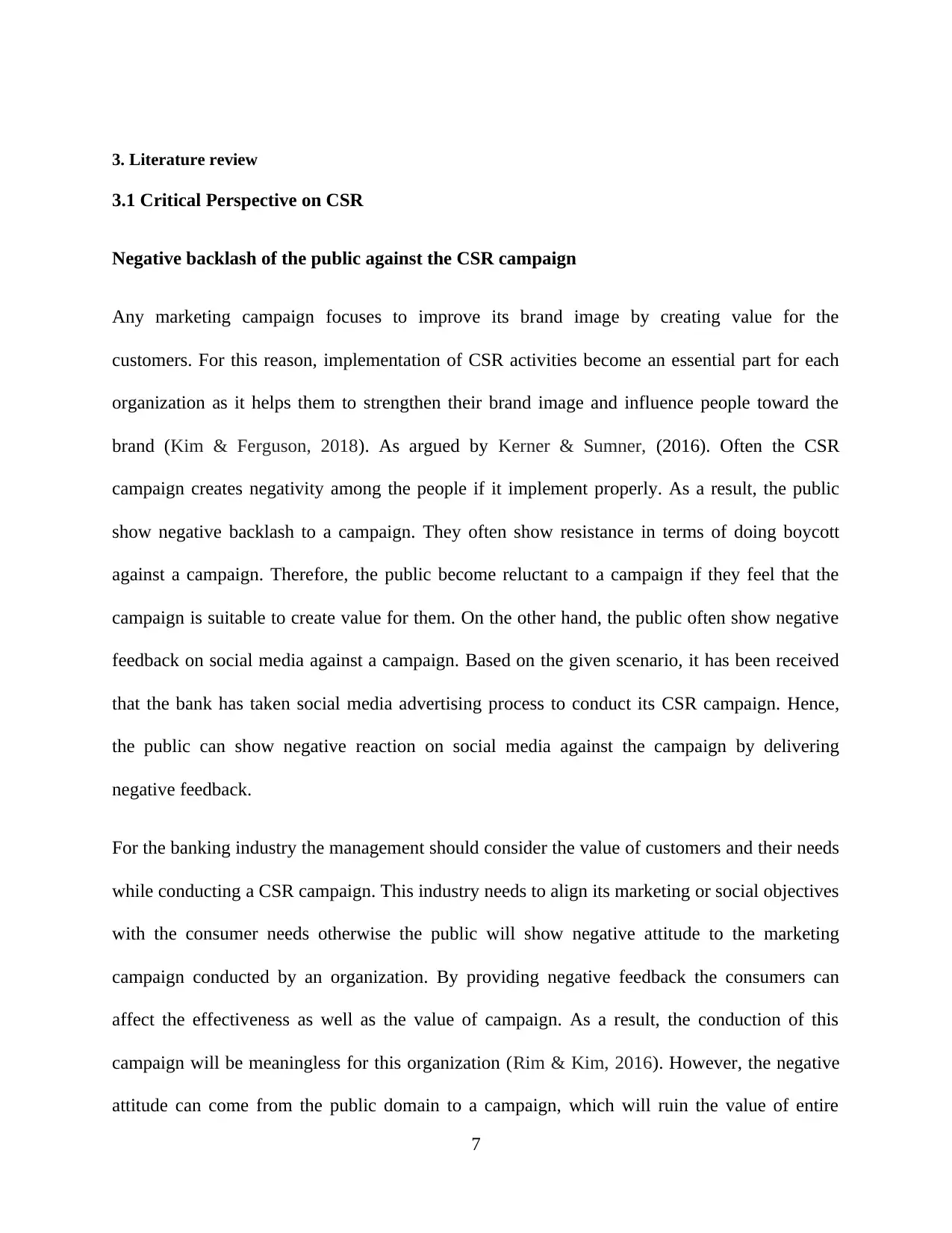
3. Literature review
3.1 Critical Perspective on CSR
Negative backlash of the public against the CSR campaign
Any marketing campaign focuses to improve its brand image by creating value for the
customers. For this reason, implementation of CSR activities become an essential part for each
organization as it helps them to strengthen their brand image and influence people toward the
brand (Kim & Ferguson, 2018). As argued by Kerner & Sumner, (2016). Often the CSR
campaign creates negativity among the people if it implement properly. As a result, the public
show negative backlash to a campaign. They often show resistance in terms of doing boycott
against a campaign. Therefore, the public become reluctant to a campaign if they feel that the
campaign is suitable to create value for them. On the other hand, the public often show negative
feedback on social media against a campaign. Based on the given scenario, it has been received
that the bank has taken social media advertising process to conduct its CSR campaign. Hence,
the public can show negative reaction on social media against the campaign by delivering
negative feedback.
For the banking industry the management should consider the value of customers and their needs
while conducting a CSR campaign. This industry needs to align its marketing or social objectives
with the consumer needs otherwise the public will show negative attitude to the marketing
campaign conducted by an organization. By providing negative feedback the consumers can
affect the effectiveness as well as the value of campaign. As a result, the conduction of this
campaign will be meaningless for this organization (Rim & Kim, 2016). However, the negative
attitude can come from the public domain to a campaign, which will ruin the value of entire
7
3.1 Critical Perspective on CSR
Negative backlash of the public against the CSR campaign
Any marketing campaign focuses to improve its brand image by creating value for the
customers. For this reason, implementation of CSR activities become an essential part for each
organization as it helps them to strengthen their brand image and influence people toward the
brand (Kim & Ferguson, 2018). As argued by Kerner & Sumner, (2016). Often the CSR
campaign creates negativity among the people if it implement properly. As a result, the public
show negative backlash to a campaign. They often show resistance in terms of doing boycott
against a campaign. Therefore, the public become reluctant to a campaign if they feel that the
campaign is suitable to create value for them. On the other hand, the public often show negative
feedback on social media against a campaign. Based on the given scenario, it has been received
that the bank has taken social media advertising process to conduct its CSR campaign. Hence,
the public can show negative reaction on social media against the campaign by delivering
negative feedback.
For the banking industry the management should consider the value of customers and their needs
while conducting a CSR campaign. This industry needs to align its marketing or social objectives
with the consumer needs otherwise the public will show negative attitude to the marketing
campaign conducted by an organization. By providing negative feedback the consumers can
affect the effectiveness as well as the value of campaign. As a result, the conduction of this
campaign will be meaningless for this organization (Rim & Kim, 2016). However, the negative
attitude can come from the public domain to a campaign, which will ruin the value of entire
7
Paraphrase This Document
Need a fresh take? Get an instant paraphrase of this document with our AI Paraphraser
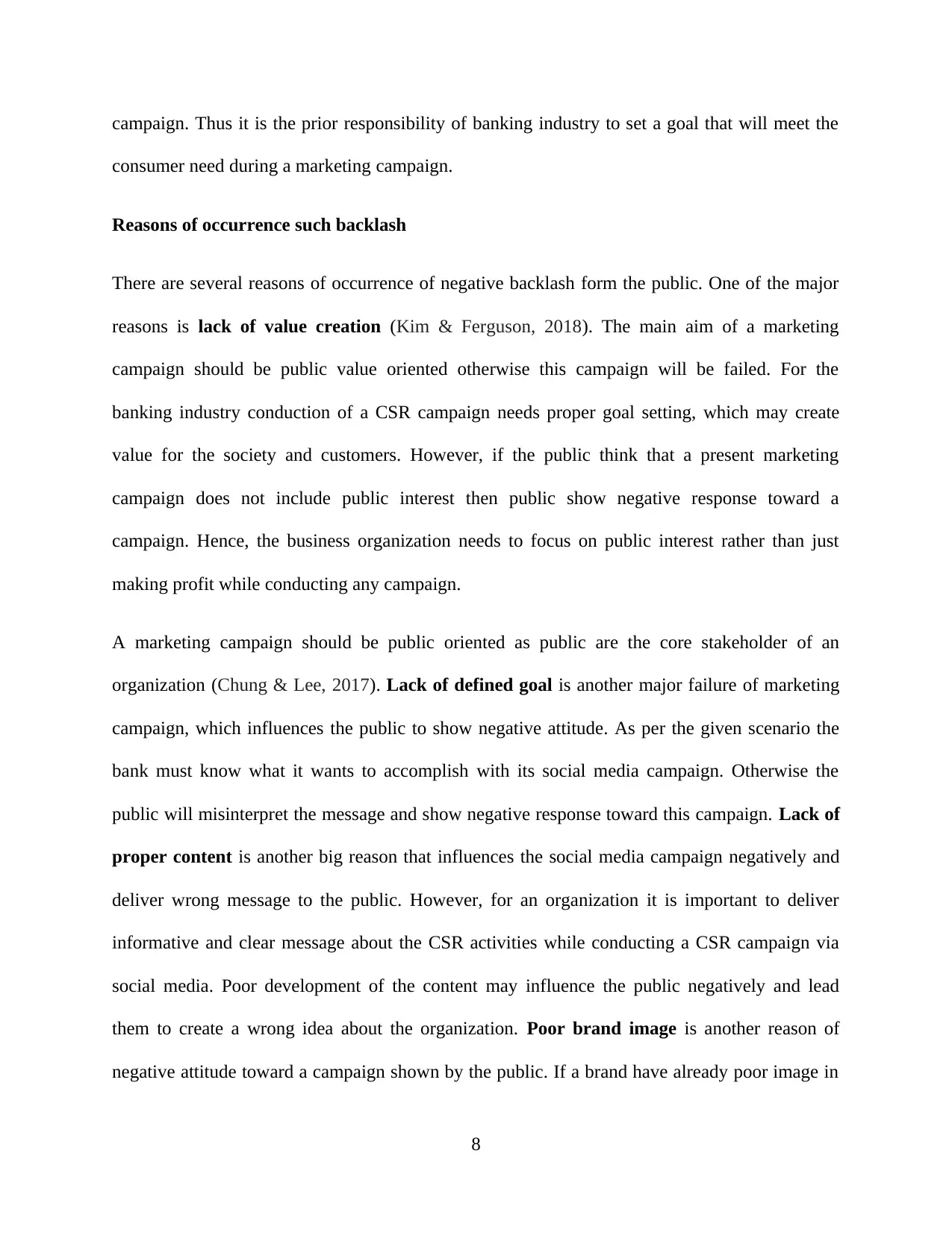
campaign. Thus it is the prior responsibility of banking industry to set a goal that will meet the
consumer need during a marketing campaign.
Reasons of occurrence such backlash
There are several reasons of occurrence of negative backlash form the public. One of the major
reasons is lack of value creation (Kim & Ferguson, 2018). The main aim of a marketing
campaign should be public value oriented otherwise this campaign will be failed. For the
banking industry conduction of a CSR campaign needs proper goal setting, which may create
value for the society and customers. However, if the public think that a present marketing
campaign does not include public interest then public show negative response toward a
campaign. Hence, the business organization needs to focus on public interest rather than just
making profit while conducting any campaign.
A marketing campaign should be public oriented as public are the core stakeholder of an
organization (Chung & Lee, 2017). Lack of defined goal is another major failure of marketing
campaign, which influences the public to show negative attitude. As per the given scenario the
bank must know what it wants to accomplish with its social media campaign. Otherwise the
public will misinterpret the message and show negative response toward this campaign. Lack of
proper content is another big reason that influences the social media campaign negatively and
deliver wrong message to the public. However, for an organization it is important to deliver
informative and clear message about the CSR activities while conducting a CSR campaign via
social media. Poor development of the content may influence the public negatively and lead
them to create a wrong idea about the organization. Poor brand image is another reason of
negative attitude toward a campaign shown by the public. If a brand have already poor image in
8
consumer need during a marketing campaign.
Reasons of occurrence such backlash
There are several reasons of occurrence of negative backlash form the public. One of the major
reasons is lack of value creation (Kim & Ferguson, 2018). The main aim of a marketing
campaign should be public value oriented otherwise this campaign will be failed. For the
banking industry conduction of a CSR campaign needs proper goal setting, which may create
value for the society and customers. However, if the public think that a present marketing
campaign does not include public interest then public show negative response toward a
campaign. Hence, the business organization needs to focus on public interest rather than just
making profit while conducting any campaign.
A marketing campaign should be public oriented as public are the core stakeholder of an
organization (Chung & Lee, 2017). Lack of defined goal is another major failure of marketing
campaign, which influences the public to show negative attitude. As per the given scenario the
bank must know what it wants to accomplish with its social media campaign. Otherwise the
public will misinterpret the message and show negative response toward this campaign. Lack of
proper content is another big reason that influences the social media campaign negatively and
deliver wrong message to the public. However, for an organization it is important to deliver
informative and clear message about the CSR activities while conducting a CSR campaign via
social media. Poor development of the content may influence the public negatively and lead
them to create a wrong idea about the organization. Poor brand image is another reason of
negative attitude toward a campaign shown by the public. If a brand have already poor image in
8
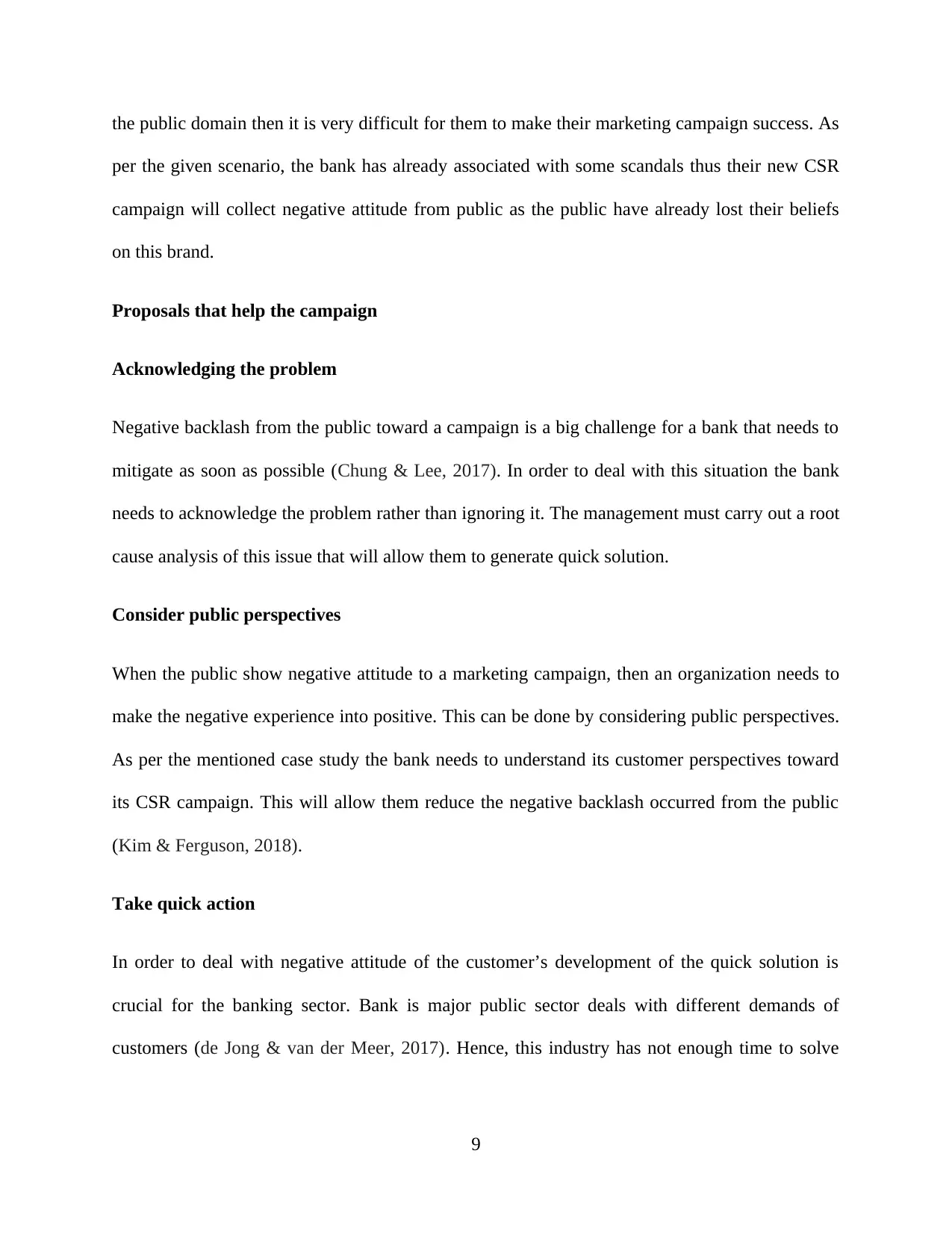
the public domain then it is very difficult for them to make their marketing campaign success. As
per the given scenario, the bank has already associated with some scandals thus their new CSR
campaign will collect negative attitude from public as the public have already lost their beliefs
on this brand.
Proposals that help the campaign
Acknowledging the problem
Negative backlash from the public toward a campaign is a big challenge for a bank that needs to
mitigate as soon as possible (Chung & Lee, 2017). In order to deal with this situation the bank
needs to acknowledge the problem rather than ignoring it. The management must carry out a root
cause analysis of this issue that will allow them to generate quick solution.
Consider public perspectives
When the public show negative attitude to a marketing campaign, then an organization needs to
make the negative experience into positive. This can be done by considering public perspectives.
As per the mentioned case study the bank needs to understand its customer perspectives toward
its CSR campaign. This will allow them reduce the negative backlash occurred from the public
(Kim & Ferguson, 2018).
Take quick action
In order to deal with negative attitude of the customer’s development of the quick solution is
crucial for the banking sector. Bank is major public sector deals with different demands of
customers (de Jong & van der Meer, 2017). Hence, this industry has not enough time to solve
9
per the given scenario, the bank has already associated with some scandals thus their new CSR
campaign will collect negative attitude from public as the public have already lost their beliefs
on this brand.
Proposals that help the campaign
Acknowledging the problem
Negative backlash from the public toward a campaign is a big challenge for a bank that needs to
mitigate as soon as possible (Chung & Lee, 2017). In order to deal with this situation the bank
needs to acknowledge the problem rather than ignoring it. The management must carry out a root
cause analysis of this issue that will allow them to generate quick solution.
Consider public perspectives
When the public show negative attitude to a marketing campaign, then an organization needs to
make the negative experience into positive. This can be done by considering public perspectives.
As per the mentioned case study the bank needs to understand its customer perspectives toward
its CSR campaign. This will allow them reduce the negative backlash occurred from the public
(Kim & Ferguson, 2018).
Take quick action
In order to deal with negative attitude of the customer’s development of the quick solution is
crucial for the banking sector. Bank is major public sector deals with different demands of
customers (de Jong & van der Meer, 2017). Hence, this industry has not enough time to solve
9
⊘ This is a preview!⊘
Do you want full access?
Subscribe today to unlock all pages.

Trusted by 1+ million students worldwide
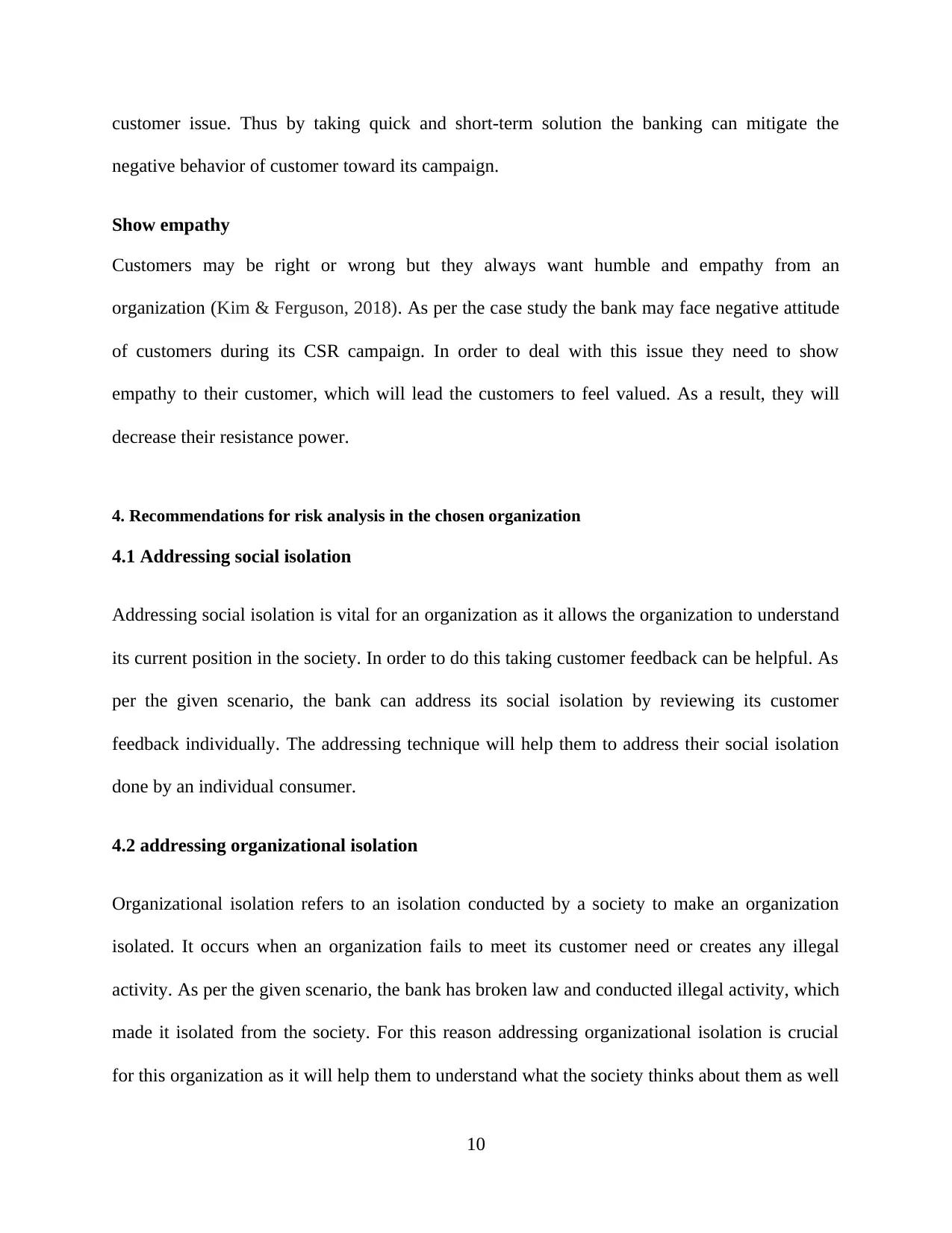
customer issue. Thus by taking quick and short-term solution the banking can mitigate the
negative behavior of customer toward its campaign.
Show empathy
Customers may be right or wrong but they always want humble and empathy from an
organization (Kim & Ferguson, 2018). As per the case study the bank may face negative attitude
of customers during its CSR campaign. In order to deal with this issue they need to show
empathy to their customer, which will lead the customers to feel valued. As a result, they will
decrease their resistance power.
4. Recommendations for risk analysis in the chosen organization
4.1 Addressing social isolation
Addressing social isolation is vital for an organization as it allows the organization to understand
its current position in the society. In order to do this taking customer feedback can be helpful. As
per the given scenario, the bank can address its social isolation by reviewing its customer
feedback individually. The addressing technique will help them to address their social isolation
done by an individual consumer.
4.2 addressing organizational isolation
Organizational isolation refers to an isolation conducted by a society to make an organization
isolated. It occurs when an organization fails to meet its customer need or creates any illegal
activity. As per the given scenario, the bank has broken law and conducted illegal activity, which
made it isolated from the society. For this reason addressing organizational isolation is crucial
for this organization as it will help them to understand what the society thinks about them as well
10
negative behavior of customer toward its campaign.
Show empathy
Customers may be right or wrong but they always want humble and empathy from an
organization (Kim & Ferguson, 2018). As per the case study the bank may face negative attitude
of customers during its CSR campaign. In order to deal with this issue they need to show
empathy to their customer, which will lead the customers to feel valued. As a result, they will
decrease their resistance power.
4. Recommendations for risk analysis in the chosen organization
4.1 Addressing social isolation
Addressing social isolation is vital for an organization as it allows the organization to understand
its current position in the society. In order to do this taking customer feedback can be helpful. As
per the given scenario, the bank can address its social isolation by reviewing its customer
feedback individually. The addressing technique will help them to address their social isolation
done by an individual consumer.
4.2 addressing organizational isolation
Organizational isolation refers to an isolation conducted by a society to make an organization
isolated. It occurs when an organization fails to meet its customer need or creates any illegal
activity. As per the given scenario, the bank has broken law and conducted illegal activity, which
made it isolated from the society. For this reason addressing organizational isolation is crucial
for this organization as it will help them to understand what the society thinks about them as well
10
Paraphrase This Document
Need a fresh take? Get an instant paraphrase of this document with our AI Paraphraser
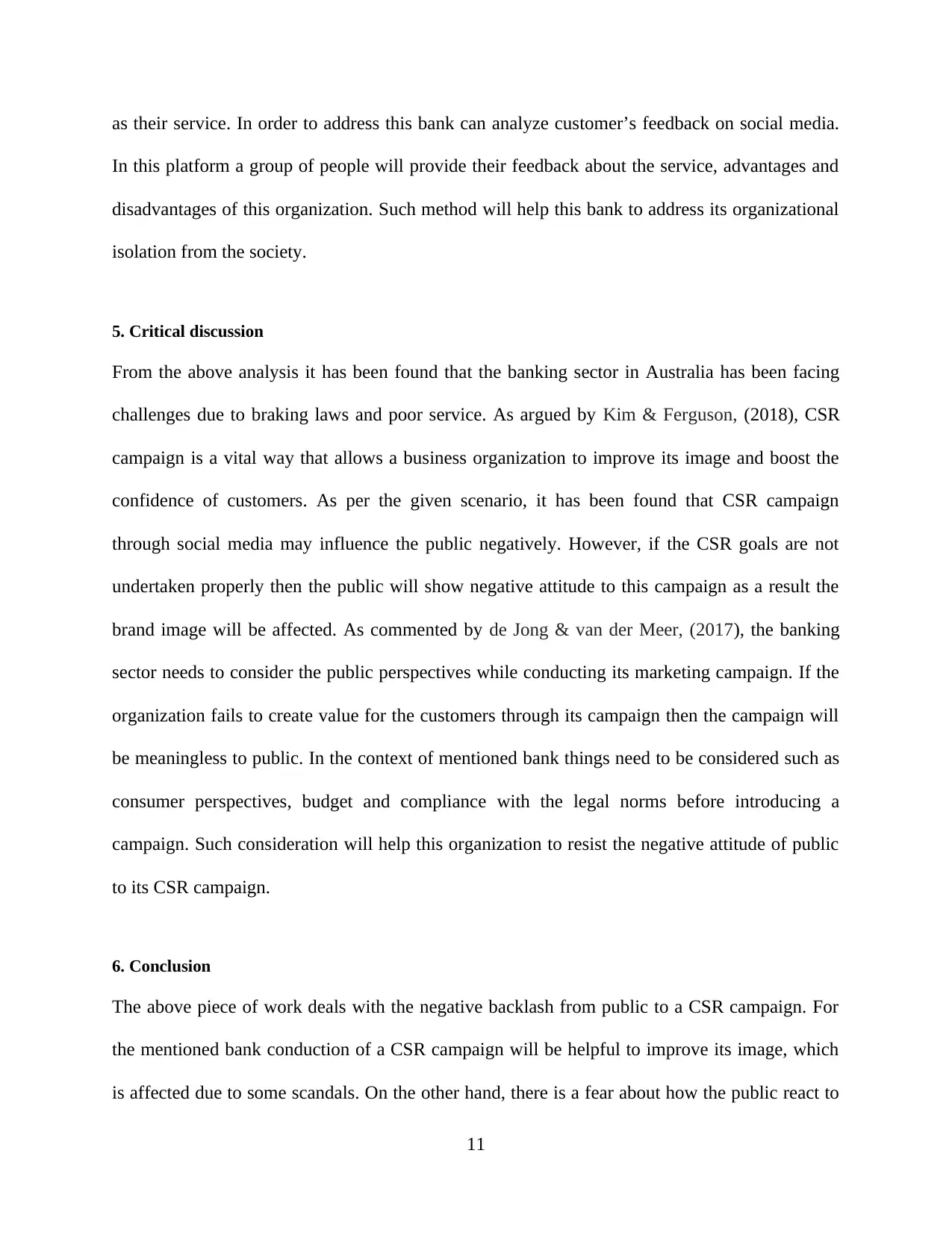
as their service. In order to address this bank can analyze customer’s feedback on social media.
In this platform a group of people will provide their feedback about the service, advantages and
disadvantages of this organization. Such method will help this bank to address its organizational
isolation from the society.
5. Critical discussion
From the above analysis it has been found that the banking sector in Australia has been facing
challenges due to braking laws and poor service. As argued by Kim & Ferguson, (2018), CSR
campaign is a vital way that allows a business organization to improve its image and boost the
confidence of customers. As per the given scenario, it has been found that CSR campaign
through social media may influence the public negatively. However, if the CSR goals are not
undertaken properly then the public will show negative attitude to this campaign as a result the
brand image will be affected. As commented by de Jong & van der Meer, (2017), the banking
sector needs to consider the public perspectives while conducting its marketing campaign. If the
organization fails to create value for the customers through its campaign then the campaign will
be meaningless to public. In the context of mentioned bank things need to be considered such as
consumer perspectives, budget and compliance with the legal norms before introducing a
campaign. Such consideration will help this organization to resist the negative attitude of public
to its CSR campaign.
6. Conclusion
The above piece of work deals with the negative backlash from public to a CSR campaign. For
the mentioned bank conduction of a CSR campaign will be helpful to improve its image, which
is affected due to some scandals. On the other hand, there is a fear about how the public react to
11
In this platform a group of people will provide their feedback about the service, advantages and
disadvantages of this organization. Such method will help this bank to address its organizational
isolation from the society.
5. Critical discussion
From the above analysis it has been found that the banking sector in Australia has been facing
challenges due to braking laws and poor service. As argued by Kim & Ferguson, (2018), CSR
campaign is a vital way that allows a business organization to improve its image and boost the
confidence of customers. As per the given scenario, it has been found that CSR campaign
through social media may influence the public negatively. However, if the CSR goals are not
undertaken properly then the public will show negative attitude to this campaign as a result the
brand image will be affected. As commented by de Jong & van der Meer, (2017), the banking
sector needs to consider the public perspectives while conducting its marketing campaign. If the
organization fails to create value for the customers through its campaign then the campaign will
be meaningless to public. In the context of mentioned bank things need to be considered such as
consumer perspectives, budget and compliance with the legal norms before introducing a
campaign. Such consideration will help this organization to resist the negative attitude of public
to its CSR campaign.
6. Conclusion
The above piece of work deals with the negative backlash from public to a CSR campaign. For
the mentioned bank conduction of a CSR campaign will be helpful to improve its image, which
is affected due to some scandals. On the other hand, there is a fear about how the public react to
11
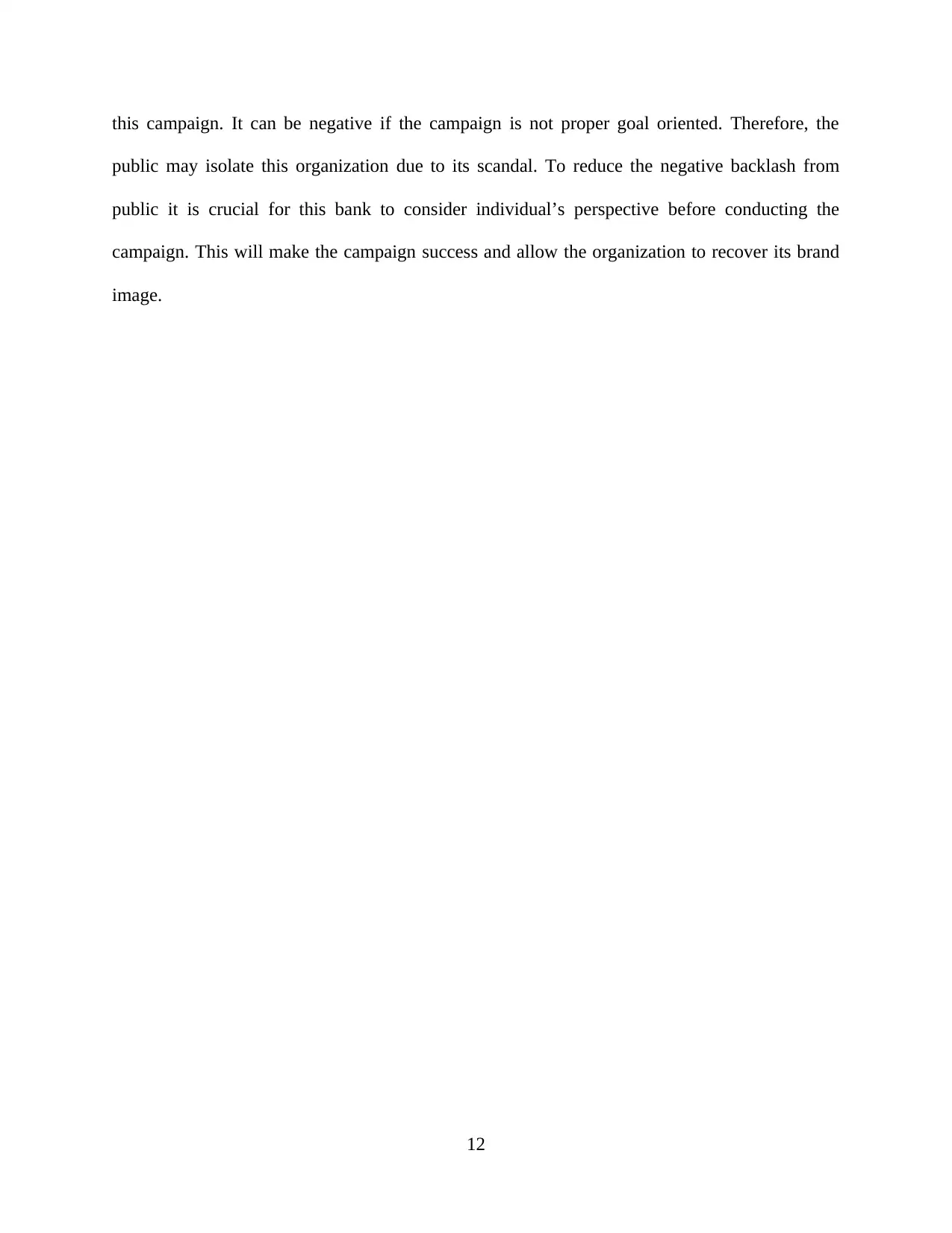
this campaign. It can be negative if the campaign is not proper goal oriented. Therefore, the
public may isolate this organization due to its scandal. To reduce the negative backlash from
public it is crucial for this bank to consider individual’s perspective before conducting the
campaign. This will make the campaign success and allow the organization to recover its brand
image.
12
public may isolate this organization due to its scandal. To reduce the negative backlash from
public it is crucial for this bank to consider individual’s perspective before conducting the
campaign. This will make the campaign success and allow the organization to recover its brand
image.
12
⊘ This is a preview!⊘
Do you want full access?
Subscribe today to unlock all pages.

Trusted by 1+ million students worldwide
1 out of 15
Related Documents
Your All-in-One AI-Powered Toolkit for Academic Success.
+13062052269
info@desklib.com
Available 24*7 on WhatsApp / Email
![[object Object]](/_next/static/media/star-bottom.7253800d.svg)
Unlock your academic potential
Copyright © 2020–2025 A2Z Services. All Rights Reserved. Developed and managed by ZUCOL.





